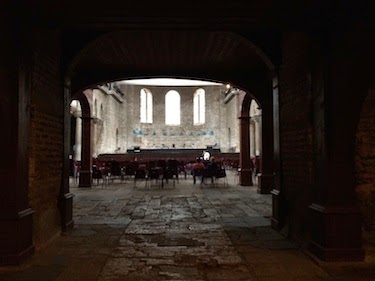Sometimes you visit a place for its beauty, sometimes for its fun, and sometimes for its convenience. And sometimes you visit a place for its history.
When you visit Istanbul, one of the top attractions on your must-see list is the Hagia-Sofia (pronounced HI-ya so-FEE-yuh). We will, of course, blog about this top attraction in due course. Today we’re talking about the lesser-known Hagia-Irene.
Like Hagia-Sofia, Hagia-Irene is an ancient Christian church. You’ll find it just inside the outer gates of the Topkapi (Sultan’s) palace. It is older than the Hagia-Sofia and was commissioned and dedicated by Constantine himself. “Irene” doesn’t refer to a saint’s name, but instead it means “divine peace”; literally, Hagia-Irene means “church of the divine peace”. While it’s not as large and impressive, nor as pretty as Hagia-Sofia, an important event in the history of the Christian faith took place here.
We like to think of the history of the church as fluid and consistent, with a (fairly) clean apostolic succession from Saint Peter to Pope Francis, but the truth is that the early church was chaotic and frequently bickering. Bishops exercised nearly complete local power in interpreting scripture and preaching to their flocks, and over the first few centuries of the faith, disputes and differences of opinions naturally cropped up. We know of one such dispute–whether Gentiles could become Christian–from the Acts of the Apostles. Those early bishops didn’t have the benefits of modern communications to compare notes, so the only way to resolve their disputes and come to a consensus was to get together in a council (the example having been set in the Acts of the Apostles).
The first such “ecumenical” council was held in Nicaea and achieved the momentous goal of codifying Christianity into a single statement of beliefs, or creed: the Nicene Creed. The second ecumenical council, known as the First Council of Constantinople, was held at Hagia-Irene.
This council of early bishops was called to address a couple of controversies that had arisen in the church. In one case the divinity of Jesus was debated, and in another the divine role of the Holy Spirit was considered. While it’s best known as the council to first confirm the divinity of Jesus, because the role of the Holy Spirit was also considered, the complete picture is that it was the council that established the concept of the Holy Trinity.
 |
| Within These Walls, the Concept of the Holy Trinity Was Established |
Another interesting outcome of the second ecumenical council has had important repercussions through history to today. The council changed the priority of the bishops, with the Bishop of Constantinople achieving second place behind the Bishop of Rome, knocking the Bishops of Antioch and Alexandria out of a privileged position. It was certainly more a political move than a ecclesiastical decree: the new capital of Constantinople (now Istanbul) was an important new city to the Roman empire. Doing such, however, served to further drive a wedge between the western, Roman, church and the eastern churches, a wedge which continues to this day.







